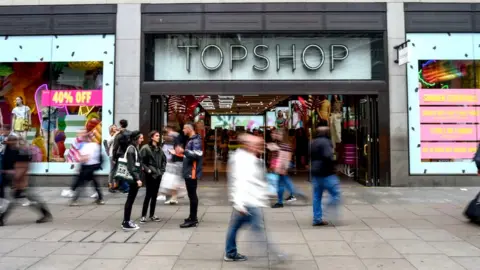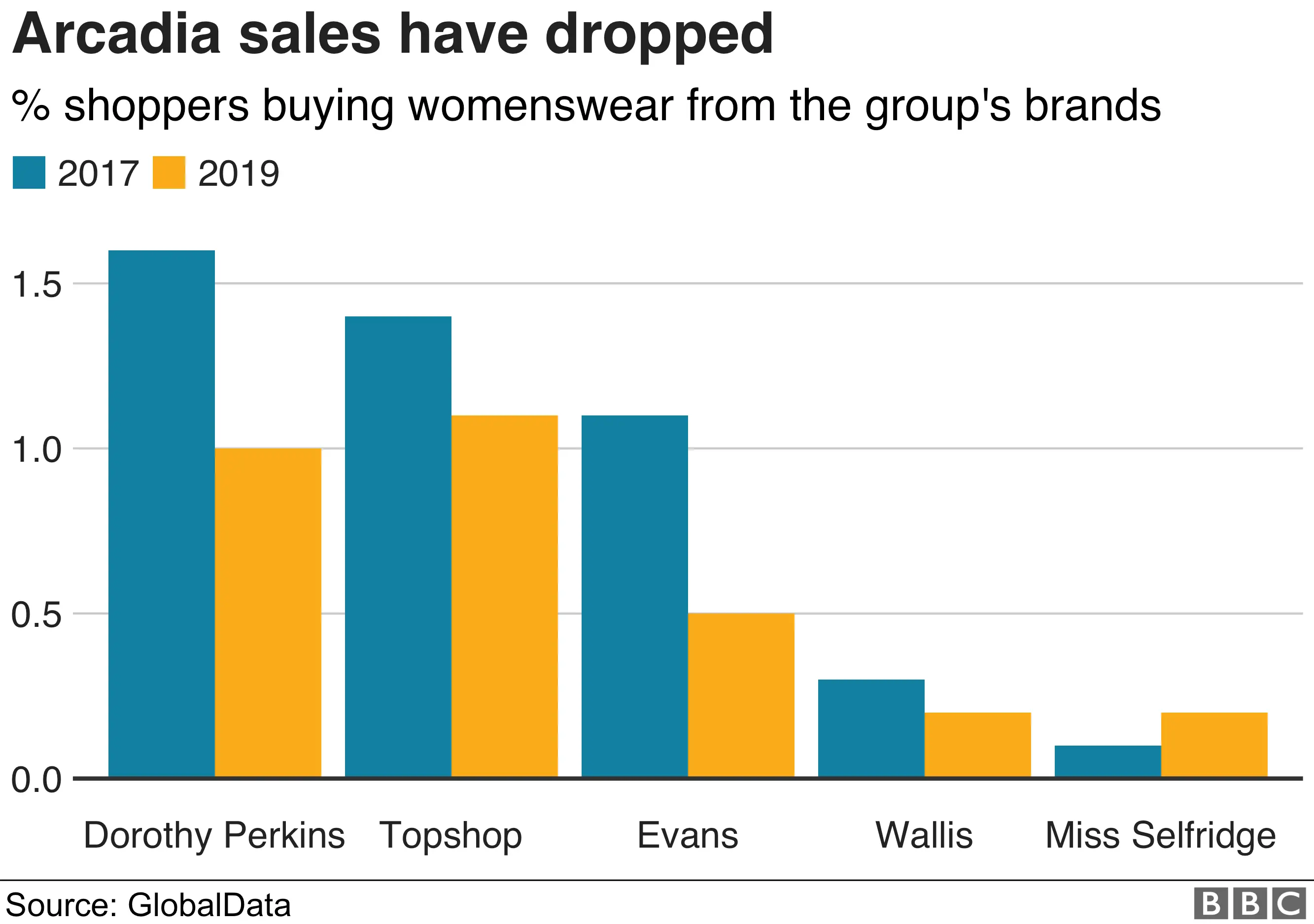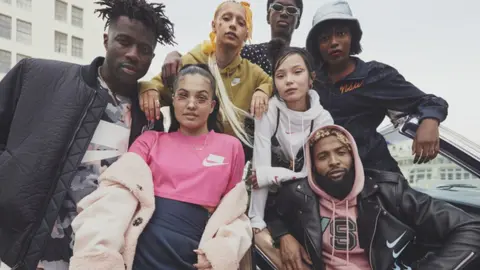Topshop: 'It's not really how I dress'
 BBC
BBC"I'm a lot less interested in Topshop nowadays, it's just not really how I dress," says 24-year-old advertising account executive Beth Armstrong.
Customers like Ms Armstrong are one of the reasons that UK High Street retail chain Arcadia, owner of popular brands such as Topshop, Miss Selfridge and Dorothy Perkins, is in trouble and seeking a rescue deal.
"What's in style right now is streetwear, and Topshop hasn't got much of that," she tells the BBC.
Ms Armstrong is a typical consumer, someone who used to shop there often, but has since moved onto other brands.
Meanwhile, she says that people younger than her don't see Topshop's styles as being "on trend".
Of course, the current retail environment is tough, but consumers still like to shop - they're just pickier about where.
At the peak of its popularity, Topshop clothes could be found in the pages of Vogue alongside high-end couture, but now it's a different story.
Have we just fallen out of love with Topshop?
 Getty Images
Getty Images"[People] are shopping at places like & Other Stories, Weekday, Cos and Urban Outfitters," says Ms Armstrong.
"I also buy a lot of stuff from Nike."
Ms Armstrong's friend and colleague Catherine Thynne, also 24, is more positive about Topshop, but buys less than half of her wardrobe from the retailer nowadays.
"I shop in Topshop loads, but the fashionability is a bit hit and miss," she says.
Both Ms Thynne and Ms Armstrong also buy a lot of clothes online, from places such as Asos, Pretty Little Things and Missguided.

Young men the BBC spoke to had a similarly negative impression of Topman.
"It's definitely less popular - they're quite behind what men want to wear," says university student Ben Reynolds, 19.
"It's generic - you get your essentials from Topman like black t-shirts or jeans, but if you want more fashionable stuff you go to Urban Outfitters."
Threat from sports brands
Their views don't come as a surprise to Maureen Hinton, retail research director at GlobalData, because fashion retailers are now facing much stronger competition from newer brands.
"Topshop tends to be more expensive than its competitors but it doesn't have the fashion kudos anymore - if you're paying a premium, it isn't exactly worth it now," she tells the BBC.
"And Miss Selfridge is quite niche [in its appeal]."
 Nike
NikeMs Hinton cites former Topshop brand director Jane Shepherdson as a "visionary" leader who marketed the brand "strongly". Without strong leadership, a strong brand identity and a lack of investment, she feels that the retailer is floundering.
And then there's the threat from sportswear brands.
"Another factor in diluting the sales of these secondary fashion brands is how strong the sports brands have become with athleisure fashion," she says.
Ms Hinton says sports brands such as Adidas and Nike are now competing directly with fashion brands: "The spending is being spread across more retailers. Topshop is not top of the list anymore."
Mixed marketing messages
Natalie Berg, retail analyst at NBK Retail, feels that Topshop and Miss Selfridge have fallen behind in popularity because they haven't been as aggressive in embracing technology as other retailers have.
"Topshop is an iconic brand but its main problem is that it hasn't followed the customer. It's still too reliant on concessions in department stores when it should really be focused on the 21st Century version - online marketplaces and social commerce," she says.
"Partnering with Asos is a great move but they're clutching at straws now, this is something they should have done years ago."
And although Topshop's flagship store in Oxford Street, London features experiences galore, this same strategy is not implemented across the rest of its outlets.
 House of Lady Muck
House of Lady MuckSimon Penson, founder and managing director of UK-based digital content marketing agency, Zazzle Media, disagrees with Ms Berg about Topshop's use of technology.
Topshop was one of the first retailers to launch an app. The real problem, he says, is that Topshop "doesn't have a cohesive marketing approach".
He feels the retailer has also missed a trick by not collaborating with influencers on collections.
"They should have clarified a digital approach and an in-store approach that would work together," he says.
According to Zazzle Media, online brands Boohoo and Asos, as well as High Street retailer New Look, began using digital marketing features like catwalk videos and inspirational photo collections featuring outfit ideas in 2011 and 2012 respectively to promote products.
In comparison, Topshop's website still doesn't have catwalk videos, and its photo collection section - showing models in various outfits - is less sophisticated than other websites.
The Philip Green factor
But it's not just about the clothes.
In recent years, Arcadia's chief executive Sir Philip Green has been in the media a lot - with allegations, which he denies - of sexual harassment and anti-feminist views.
With the digital age, all of this information is readily accessible online, and some young people have told the BBC that they no longer feel comfortable supporting brands owned by Sir Philip.

"Generation Z tends to stick with their morals more than any other generation when it comes to purchases, and they exercise brand loyalty more than anyone else," says Mr Penson.
Jamie Windust, 22, a popular influencer on Instagram with over 27,000 followers, who has collaborated with Asos in the past on campaigns targeting the LGBTQ+ community, tells the BBC:
"I have noticed I'm cutting down - I try to shop where my ethics lie. I get sent a lot of stuff from High Street brands, but I tend to shop either vintage or charity shop.
"When working with brands, it really depends on the message behind the campaign."
